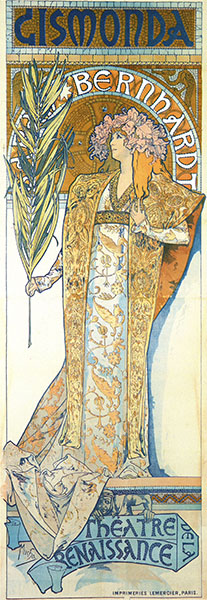ART NOUVEAU ……….
The Art Nouveau style became recognized in the 1880s and was
sometimes known as the “New Art”.
The philosophy behind this new style of art was that LIFE WAS ART, so this became the art of
the people and therefore anything that had to do with life was expected to be
treated as a form of art. The Art
Nouveau style, which was based on nature and the organic beauty, was the
opposite of the Classical and Academic Art.
Therefore, the rich people were not so happy about this new art belief
because until then Classic Art was reserved for them!
The
exponents of the Art Nouveau were inspired by the British Arts and Crafts
Movement but, unlike them, they were not concerned with social reforms. The Art Nouveau Movement was also influenced by
the Aesthetic Movement, especially by its use of motifs taken from nature. Other influences were Rococo (France), Celtic art, Japanese art, Egyptian art and Gothic
Revival. However, the Art Nouveau
designers and architects did not use any past design ideas, not even from other
cultures, even though they mostly admired the Japanese approach to nature. They came up with original ideas, and they
considered nature as the true source
of all good design.
There were
several architects and designers who contributed to the development of the Art
Nouveau style, including Victor Horta,
Hector Guimard
and Henry van de Velde. Victor Horta, who was a Belgian architect, was
in fact one of the greatest exponents of this particular style, with Hotel
Tassel (1892-1893) being one of his first architectural examples of Art
Nouveau.
Alex Coopey. (2013). Art Nouveau. [Online Video]. 04 February. Available from: https://www.youtube.com/watch?v=Vik4YYcG_D4.
[Accessed: 19 October 2013]
[Accessed: 19 October 2013]
Victor Horta
Jean Ferrat, (2011), Victor Horta [ONLINE]. Available at: http://lembellie-bruxelles.blogspot.com/2011/05/victor-horta-lost-world.html
[Accessed 19 October 13]
[Accessed 19 October 13]
The famous staircase in Hotel Tassel by Victor Horta

Hector Guimard

The Porte Dauphine Station

Henry Van De Velde

Poster
emmabanana, (2010), Tropon by Henry van de Velde in 1899. [ONLINE]. Available at: http://thevisualarchive.blogspot.com/2010/10/art-nouveau-work-featuring-aubrey.html
[Accessed 19 October 13]
A
distinguishing graphic design style was developed. This included typography styles, as well as a
characteristic manner of drawing the figure of a female. Examples of this particular style are the
prints of Aubrey Beardsley and
Alphonse Mucha. Mucha was also one of
the first creators of posters produced in the Art Nouveau style. His first poster for the play "Gismonda" became very popular and other
designers were inspired by his work.

marisayutub. (2010). Alphonse Mucha - Art Nouveau. [Online Video]. 23 July. Available from: http://www.youtube.com/watch?v=KSIZC8-ksqY.
[Accessed: 19 October 2013]
Other important examples of Art Nouveau style include the glass and jewellery design of Lalique, as well as the stained glass and other designs of Louis Comfort Tiffany and Emile Galle.
Rene` Lalique

O My Opera, (2013), Le Génial Jules-René Lalique [ONLINE]. Available at: http://my.opera.com/montcha670629/albums/showpic.dml?album=875659&picture=11985154
[Accessed 19 October 13]
[Accessed 19 October 13]
Dragonfly Corsage (gold, enamel, chrysoprase stones, moonstones) by Lalique (1897-8)
H Y D R A , (2011), Dragonfly corsage Lalique 1897-1898 [ONLINE].
Louis Comfort Tiffany

gaukartifact , (2013), Louis Comfort Tiffany (1848–1933) [ONLINE]. Available at: http://gaukartifact.com/2013/02/27/louis-comfort-tiffany-1848-1933/
[Accessed 19 October 13]
[Accessed 19 October 13]
Tiffany’s “Wisteria” lamp (circa 1902)
& ampersandVintage Modern, (2013), Tiffany’s “Wisteria” lamp, c. 1902 [ONLINE]. Available at: http://ampersandvintagemodern.wordpress.com/
[Accessed 19 October 13]
[Accessed 19 October 13]
Emile Galle
Macklowe Gallery, (2013), Emelli Galle` [ONLINE]. Available at: http://www.macklowegallery.com/education.asp/art+nouveau/Artist+Biographies
[Accessed 19 October 13]
'Red Onion' wheel carved cameo vase with a marquetry glass foot, a removable leaf-form stopper and an engraved signature to the side by Emile Galle
News-Antique.com, (2013), Emile Galle 'Red Onion' wheel carved cameo vase [ONLINE].
[Accessed 19 October 13]
Other References:
Art, Design, and Visual Thinking. 1995. Art Nouveau . [ONLINE] Available at: http://char.txa.cornell.edu/art/decart/artcraft/artcraft.htm.
[Accessed 19 October 13]
[Accessed 19 October 13]
Codex 99, (2011), Gismonda, 1894 and recycled for the 1896 American Tour [ONLINE]. Available at: http://www.codex99.com/design/85.html
[Accessed 19 October 13]
Book: Fiell, C.F and P.F, 1999. Design of the 20th Century. 2nd ed. Germany: Taschen






No comments:
Post a Comment